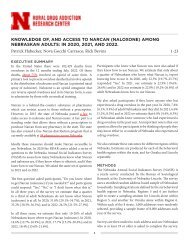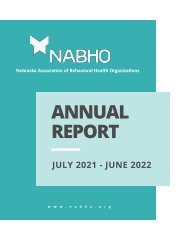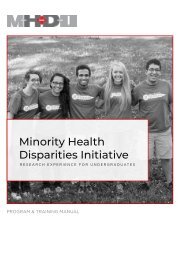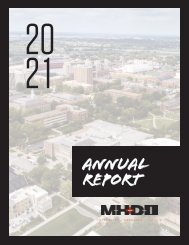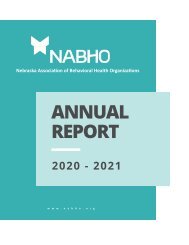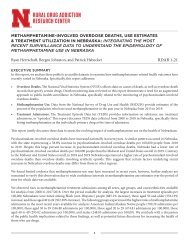Analysis of Nebraskan Admissions to Publicly Funded Substance Treatment Centers in 2017 by Core-Based Statistical Areas copy
Create successful ePaper yourself
Turn your PDF publications into a flip-book with our unique Google optimized e-Paper software.
RURAL DRUG ADDICTION<br />
RESEARCH CENTER<br />
ANALYSIS OF NEBRASKAN ADMISSIONS TO PUBLICLY FUNDED SUBSTANCE<br />
TREATMENT CENTERS IN <strong>2017</strong> BY CORE-BASED STATISTICAL AREAS<br />
Patrick Habecker & Ryan Herrschaft<br />
RDAR 2-20<br />
EXECUTIVE SUMMARY<br />
The <strong>Treatment</strong> Episode Data Set (TEDS) tracks both admissions and discharges from substance use treatment facilities<br />
<strong>in</strong> the United States <strong>of</strong> America. <strong>Treatment</strong> facilities <strong>in</strong> Nebraska that receive public funds from the state substance abuse<br />
agency are required <strong>to</strong> submit <strong>in</strong>formation for the TEDS.<br />
We analyze TEDS data <strong>to</strong> look at differences <strong>in</strong> substances reported at admission <strong>in</strong> Nebraska between Metropolitan corebased<br />
statistical areas (CBSA) counties, Micropolitan CBSA counties, and counties that are Outside CBSA areas. Nebraska<br />
has four Metropolitan CBSAs: Omaha, L<strong>in</strong>coln, Grand Island, and Sioux City. Micropolitan counties <strong>in</strong>clude <strong>to</strong>wns such<br />
as: Kearney, Hast<strong>in</strong>gs, Norfolk, and Columbus. A full description <strong>of</strong> how Metro and Micro CBSA counties are def<strong>in</strong>ed is<br />
<strong>in</strong>cluded <strong>in</strong> this report.<br />
In <strong>2017</strong>, 52.61% <strong>of</strong> all admissions <strong>to</strong> treatment centers were <strong>in</strong> Metropolitan CBSAs (Omaha, L<strong>in</strong>coln, Grand Island, Sioux<br />
City). The rema<strong>in</strong>der <strong>of</strong> admissions were <strong>in</strong> Micropolitan or were Outside both Metro and Micro areas. Almost 30% <strong>of</strong><br />
admissions were <strong>in</strong> areas Outside <strong>of</strong> Metro and Micro CBSA counties.<br />
Metropolitan, Micropolitan, and Outside CBSA areas have different admission pr<strong>of</strong>iles for the substances that are listed<br />
at admission. This report looks at both how <strong>of</strong>ten a substance is listed <strong>in</strong> all admissions (the percent) and the rate <strong>of</strong> a<br />
substance be<strong>in</strong>g listed per 100,000 <strong>Nebraskan</strong>s age 10 or older.<br />
When we look at the statewide and across state numbers, there are a clear <strong>to</strong>p three substances that are listed at admission<br />
for treatment: alcohol, marijuana, and methamphetam<strong>in</strong>e. When look<strong>in</strong>g at only primary substances at admission,<br />
these three substances are the primary substance <strong>in</strong> 87.55% <strong>of</strong> all admissions <strong>in</strong> Nebraska <strong>in</strong> <strong>2017</strong> (alcohol 56.32%,<br />
methamphetam<strong>in</strong>e 21.51%, marijuana 9.72%).<br />
Alcohol is listed more frequently <strong>in</strong> Metro and Outside CBSA areas than Micro areas. However, the rates <strong>of</strong> alcohol be<strong>in</strong>g<br />
listed per 100,000 <strong>Nebraskan</strong>s age 10 or older are fairly similar between Metro and Micro areas, and much higher <strong>in</strong><br />
Outside CBSA areas. Overall, alcohol is the most commonly listed substance at admission.<br />
Marijuana and Methamphetam<strong>in</strong>e are more frequently listed <strong>in</strong> Micro areas <strong>by</strong> percent <strong>of</strong> admissions compared <strong>to</strong> Metro<br />
and Outside areas. However, when look<strong>in</strong>g at rates <strong>of</strong> list<strong>in</strong>g per 100,000 <strong>Nebraskan</strong>s age 10 or older Micro and Outside<br />
areas are quite similar and the Metro rates are lower than both Micro and Outside CBSA areas.<br />
Other substances are listed at admission, but none appear <strong>in</strong> more than 10% <strong>of</strong> admissions. The complete distribution and<br />
rate <strong>of</strong> these substances is provided <strong>in</strong> the full report.<br />
1
A FEW POINTS ON TEDS DATA, DEFINITIONS, AND OUR ANALYSIS<br />
What is TEDS?<br />
The <strong>Treatment</strong> Episode Data Set (TEDS) tracks both admissions and discharges from substance use treatment facilities <strong>in</strong><br />
the United States <strong>of</strong> America. People who are admitted or discharged multiple times <strong>in</strong> a year are counted for each <strong>in</strong>stance<br />
or episode. When review<strong>in</strong>g reports or other data products based on the TEDS the unit <strong>of</strong> analysis is admissions and not<br />
persons. This is an important dist<strong>in</strong>ction <strong>to</strong> keep <strong>in</strong> m<strong>in</strong>d as <strong>in</strong>dividual TEDS reports may represent the same person at<br />
different time po<strong>in</strong>ts <strong>in</strong> the year. The TEDS is jo<strong>in</strong>tly adm<strong>in</strong>istered <strong>by</strong> the <strong>Substance</strong> Abuse and Mental Health Services<br />
Adm<strong>in</strong>istration (SAMHSA) which is part <strong>of</strong> the U.S. Department <strong>of</strong> Health & Human Services. You can learn more about<br />
TEDS at the SAMHSA website l<strong>in</strong>ked here and download the data that we used for this report.<br />
Where does TEDS data come from?<br />
<strong>Treatment</strong> facilities <strong>in</strong> Nebraska that receive public funds from the state substance abuse agency are required <strong>to</strong> submit<br />
<strong>in</strong>formation for the TEDS. These facilities provide <strong>in</strong>formation (such as gender and age) for each admission as well as<br />
<strong>in</strong>formation on what substances lead <strong>to</strong> each admission episode.<br />
What does TEDS data not <strong>in</strong>clude?<br />
<strong>Treatment</strong> facilities that do not receive public fund<strong>in</strong>g from the state or federal government are not required <strong>to</strong> submit<br />
<strong>in</strong>formation <strong>to</strong> TEDS. Private facilities may voluntarily report this <strong>in</strong>formation, but none did so <strong>in</strong> Nebraska for <strong>2017</strong>.<br />
How are we Def<strong>in</strong><strong>in</strong>g Metropolitan, Micropolitan, and Outside CBSA <strong>Areas</strong>?<br />
The TEDS system reports if an admission occurred with<strong>in</strong> a <strong>Core</strong>-<strong>Based</strong> <strong>Statistical</strong> Area (CBSA), and provides a unique code<br />
for each CBSA <strong>in</strong> the United States. We then classify those <strong>in</strong>dividual CBSA areas as Metropolitan, Micropolitan, or Outside<br />
a CBSA and comb<strong>in</strong>e them <strong>in</strong><strong>to</strong> our three categories. CBSA areas are def<strong>in</strong>ed <strong>by</strong> the U.S. Census Bureau and use measures<br />
<strong>of</strong> population, county boundaries, and social and economic ties between counties around a population core. These are not<br />
strictly urban-rural classifications as county boundaries can encompass areas that are both rural and urban.<br />
A metropolitan CBSA will have a core population <strong>of</strong> at least 50,000 people. A micropolitan CBSA has a population <strong>of</strong> at least<br />
10,000, but less than 50,000 people. Outly<strong>in</strong>g counties are added <strong>to</strong> a CBSA if at least 25% <strong>of</strong> workers liv<strong>in</strong>g <strong>in</strong> that county<br />
work <strong>in</strong> the central counties or if at least 25% <strong>of</strong> the employment <strong>in</strong> the outly<strong>in</strong>g county is occupied <strong>by</strong> workers who live <strong>in</strong><br />
the central counties. Counties <strong>in</strong> a state that are not part <strong>of</strong> a CBSA are referred <strong>to</strong> as Outside <strong>Core</strong> <strong>Based</strong> <strong>Statistical</strong> <strong>Areas</strong>.<br />
You can read more about the technical specifications <strong>of</strong> the <strong>Core</strong>-<strong>Based</strong> <strong>Statistical</strong> <strong>Areas</strong> here.<br />
Metropolitan CBSA areas <strong>in</strong> Nebraska <strong>in</strong> <strong>2017</strong> cover the cities <strong>of</strong> Omaha, L<strong>in</strong>coln, Grand Island, and overflow from Sioux<br />
City, Iowa. These regions <strong>in</strong>clude the follow<strong>in</strong>g counties: Wash<strong>in</strong>g<strong>to</strong>n, Douglas, Sarpy, Cass, Saunders, Lancaster, Seward,<br />
Hall, Howard, Merrick, Dakota, and Dixon.<br />
Micropolitan CBSA areas <strong>in</strong> Nebraska <strong>in</strong> <strong>2017</strong> cover the cities <strong>of</strong> Scottsbluff, North Platte, Lex<strong>in</strong>g<strong>to</strong>n, Kearney, Hast<strong>in</strong>gs,<br />
Norfolk, Columbus, Fremont, and Beatrice. These regions <strong>in</strong>clude the follow<strong>in</strong>g counties: Scotts Bluff, Sioux, Banner, L<strong>in</strong>coln,<br />
McPherson, Logan, Dawson, Gosper, Buffalo, Kearney, Adams, Madison, Stan<strong>to</strong>n, Pierce, Platte, Dodge, and Gage.<br />
Outside CBSA areas <strong>in</strong> Nebraska <strong>in</strong> <strong>2017</strong> are the rema<strong>in</strong><strong>in</strong>g 64 counties <strong>in</strong> Nebraska that are not <strong>in</strong> Metro or Micro areas.<br />
Population Rates<br />
Official TEDS reports <strong>of</strong>ten <strong>in</strong>clude the primary rate <strong>of</strong> admissions per 100,000 people who are 12 or older <strong>in</strong> a given area,<br />
whether it is a state, region, or nation. To replicate these rates <strong>of</strong> admissions <strong>in</strong> the CBSA divisions we need access <strong>to</strong> the<br />
number <strong>of</strong> people <strong>in</strong> each county <strong>of</strong> the state who are 12 and older. This <strong>in</strong>formation is not <strong>in</strong>cluded <strong>in</strong> the TEDS file. Us<strong>in</strong>g<br />
US Census resources we have not been able <strong>to</strong> f<strong>in</strong>d that exact data at the county level. Instead we calculate our rates as per<br />
100,000 people who are 10 or older <strong>in</strong> a given area. As a result, our calculated statewide rates will appear lower than what is<br />
reported <strong>by</strong> TEDS because we are us<strong>in</strong>g a larger population size.<br />
What are Primary, Secondary, and Tertiary <strong>Substance</strong>s?<br />
Up <strong>to</strong> three substances can be listed at admission <strong>to</strong> a treatment facility. These are the reported substances that led <strong>to</strong> a given<br />
treatment episode and are listed with an implied order <strong>of</strong> primary (first), secondary (second), and tertiary (third). However,<br />
2
3
if an admission has more than three substances <strong>in</strong>volved there is no record <strong>of</strong> a 4th, 5th, or more substances. We use these<br />
list<strong>in</strong>gs <strong>in</strong> two different ways for our report. First, we report on the primary substance only. This report<strong>in</strong>g ignores secondary<br />
and tertiary substances and focuses only on the first substance listed. This is follows how <strong>of</strong>ficial TEDS reports show state<strong>by</strong>-state<br />
percentages and rates for only the primary substance reported. We also report on all <strong>of</strong> the substances reported for<br />
an admission <strong>by</strong> look<strong>in</strong>g at the primary, secondary, and tertiary <strong>to</strong>gether. This shows the prevalence <strong>of</strong> all three reported<br />
substances <strong>in</strong> admission episodes and gives us a sense <strong>of</strong> how <strong>of</strong>ten a given substance is recorded as contribut<strong>in</strong>g <strong>to</strong>wards a<br />
treatment admission. Although there is likely <strong>to</strong> be a lot <strong>of</strong> overlap between substances listed for admission and substances<br />
used <strong>by</strong> a person, we do not equate the two. Because we are limited <strong>to</strong> only three reportable substances, and substances are<br />
asked as they determ<strong>in</strong>e a current admission episode, it is unwise <strong>to</strong> generalize admissions substance pr<strong>of</strong>iles <strong>to</strong> all substance<br />
use.<br />
What is <strong>in</strong>cluded <strong>in</strong> the “Other” substance category?<br />
TEDS reports on quite a few substances that we count as “Other” <strong>in</strong> this report. The substances <strong>in</strong> this category are: <strong>in</strong>halants,<br />
over the counter medications, barbiturates, other non-benzodiazep<strong>in</strong>e tranquilizers, other stimulants, other halluc<strong>in</strong>ogens,<br />
PCP, non-prescription methadone, other non-barbiturate sedatives/hypnotics, other amphetam<strong>in</strong>es, and other drugs. Full<br />
report<strong>in</strong>g <strong>of</strong> these substances at the overall state level can be found <strong>in</strong> the <strong>of</strong>ficial reports for the <strong>2017</strong> TEDS. To see these<br />
substances as the CBSA level you will need <strong>to</strong> use the orig<strong>in</strong>al data and conduct the analysis yourself. If you need a place <strong>to</strong><br />
start on this you can use our R code we used <strong>to</strong> create this report which is l<strong>in</strong>ked at the end <strong>of</strong> the report.<br />
PRIMARY SUBSTANCES AT ADMISSION<br />
Percent <strong>Admissions</strong> which List <strong>Substance</strong> as Primary - Statewide<br />
We first focus on the statewide distribution <strong>of</strong> substances that are listed as the primary substance at admission <strong>to</strong> treatment<br />
<strong>in</strong> Nebraska <strong>in</strong> <strong>2017</strong>. TEDS reports that there were 13,467 admissions <strong>to</strong> treatment facilities <strong>in</strong> Nebraska that received public<br />
funds <strong>in</strong> <strong>2017</strong>. Figure 1 shows that 56.32% <strong>of</strong> these admissions listed alcohol as the primary substance. Marijuana was listed<br />
as the primary substance for 9.72% <strong>of</strong> admissions, and methamphetam<strong>in</strong>e for 21.51% <strong>of</strong> admissions. Synthetic opioids were<br />
listed for 2.75% <strong>of</strong> admissions, coca<strong>in</strong>e or crack coca<strong>in</strong>e was listed <strong>in</strong> 1.19% <strong>of</strong> admissions, hero<strong>in</strong> was listed for 0.69% <strong>of</strong><br />
admissions, and benzodiazep<strong>in</strong>e was listed for 0.38% <strong>of</strong> admissions. For 2.46% <strong>of</strong> admissions a different substance (“other”)<br />
was listed as the primary substance. Our use <strong>of</strong> “other” will not match the standard TEDS report<strong>in</strong>g as we comb<strong>in</strong>ed quite<br />
a few smaller categories. You can see a complete list <strong>of</strong> the substances that are <strong>in</strong> our “other” category <strong>in</strong> the preced<strong>in</strong>g<br />
paragraph. This is the only category we comb<strong>in</strong>ed from the typical TEDS report<strong>in</strong>g. In 4.92% <strong>of</strong> the admissions there was no<br />
substance listed (“none”) as a primary substance.<br />
4
Percent <strong>Admissions</strong> which List <strong>Substance</strong> as Primary – Across CBSA Regions<br />
In Figure 2, we show the percent <strong>of</strong> primary substances at admission for each <strong>of</strong> three possible CBSA region types: Metro,<br />
Mico, or Outside CBSA. In brief, Metro CBSA are regions with a county core <strong>of</strong> 50,000 people or more; Micro CBSA regions<br />
have a county core <strong>of</strong> 10,000 <strong>to</strong> 49,999 people, and Outside CBSA regions have less than 10,000 people or were not classified.<br />
We refer <strong>to</strong> these areas as Metro, Micro, and Outside.<br />
Alcohol was the primary substance for 62.17% <strong>of</strong> Metro admissions, 33.92% <strong>of</strong> Micro admissions, and 59.76% <strong>of</strong> Outside<br />
admissions <strong>in</strong> <strong>2017</strong> <strong>in</strong> Nebraska. Marijuana was the primary substance for 7.58% <strong>of</strong> Metro admissions, 16.37% <strong>of</strong> Micro<br />
admissions, and 9.42% <strong>of</strong> Outside admissions. Methamphetam<strong>in</strong>e was the primary substance for 17.66% <strong>of</strong> Metro admissions,<br />
34.36% Micro admissions, and 20.43% <strong>of</strong> Outside admissions. Other substances accounted for a much smaller proportion <strong>of</strong><br />
the primary admissions <strong>in</strong> all three areas. Synthetic opioids were the primary substance for 2.91% <strong>of</strong> Metro admissions, 3.18%<br />
<strong>of</strong> Micro admissions, and 2.22% <strong>of</strong> Outside admissions. Coca<strong>in</strong>e or crack coca<strong>in</strong>e were the primary substance for 1.13% <strong>of</strong><br />
Metro admissions, 0.53% <strong>of</strong> Micro admissions, and 1.71% <strong>of</strong> Outside admissions. Hero<strong>in</strong> was the primary substance for<br />
0.75% <strong>of</strong> Metro admissions, 0.73% <strong>of</strong> Micro admissions, and 0.56% <strong>of</strong> Outside admissions. Benzodiazep<strong>in</strong>e was the primary<br />
substance for 0.44% <strong>of</strong> Metro admissions, 0.53% <strong>of</strong> Micro admissions, and 0.18% <strong>of</strong> Outside admissions. Our comb<strong>in</strong>ed<br />
“Other” primary substances were 1.89% <strong>of</strong> Metro admissions, 4.68% <strong>of</strong> Micro admissions, and 2.09% <strong>of</strong> Outside admissions.<br />
The primary substance <strong>of</strong> “None” was listed for 5.36% <strong>of</strong> Metro admissions, 5.7% <strong>of</strong> Micro admissions, and 3.62% <strong>of</strong> Outside<br />
admissions.<br />
Rate <strong>of</strong> Primary <strong>Substance</strong> at Admission per 100,000 <strong>Nebraskan</strong>s Age 10 or Older - Statewide<br />
It is also useful <strong>to</strong> consider the rate <strong>of</strong> primary substances <strong>in</strong> admissions per 100,000 people <strong>in</strong> an area. We calculate our<br />
rates as per 100,000 people who are 10 and older <strong>in</strong> Nebraska <strong>in</strong> <strong>2017</strong> us<strong>in</strong>g US Census data. Because TEDS does not track<br />
admissions for those younger than 12 our rates are slightly lower than what you would see <strong>in</strong> the <strong>of</strong>ficial TEDS report. Figure<br />
3 shows that <strong>in</strong> <strong>2017</strong> there were 458.43 primary alcohol admissions per every 100,000 people age 10 and older <strong>in</strong> Nebraska.<br />
There were 79.13 marijuana admissions, 175.12 methamphetam<strong>in</strong>e admissions, and 22.43 synthetic opioid admissions per<br />
100,000 people age 10 and older <strong>in</strong> Nebraska. The coca<strong>in</strong>e and crack coca<strong>in</strong>e admission rate was 9.67, and there were 5.62<br />
hero<strong>in</strong> admissions, and 3.08 benzodiazep<strong>in</strong>e admissions per 100,000 people age 10 and older <strong>in</strong> Nebraska.<br />
Rate <strong>of</strong> Primary <strong>Substance</strong> at Admission per 100,000 <strong>Nebraskan</strong>s Age 10 or Older – Across CBSA Regions<br />
In Figure 4 we show the rate <strong>of</strong> primary substances at admission per 100,000 <strong>Nebraskan</strong>s age 10 an older for each <strong>of</strong> three<br />
5
6
possible CBSA region types. In brief, Metro CBSA are regions with a county core <strong>of</strong> 50,000 people or more; Micro CBSA<br />
regions have a county core <strong>of</strong> 10,000 <strong>to</strong> 49,999 people, and Outside CBSA regions have less than 10,000 people or were not<br />
classified. We refer <strong>to</strong> these areas as Metro, Micro, and Outside.<br />
The primary admissions rate for alcohol was 409.87 <strong>in</strong> Metro areas, 293.57 <strong>in</strong> Micro areas, and 793 <strong>in</strong> Outside areas. The<br />
Marijuana rate was 49.97 <strong>in</strong> Metro areas, 141.67 <strong>in</strong> Micro areas, and 125.07 <strong>in</strong> Outside areas. The rate for Methamphetam<strong>in</strong>e<br />
was 116.4 <strong>in</strong> Metro areas, 297.45 <strong>in</strong> Micro areas, and 271.1 <strong>in</strong> Outside areas. The rate for synthetic opioids was 19.17 <strong>in</strong> Metro<br />
areas, 27.49 <strong>in</strong> Micro areas, and 29.41 <strong>in</strong> Outside areas. The coca<strong>in</strong>e and crack coca<strong>in</strong>e admissions rate was 7.44 <strong>in</strong> Metro<br />
areas, 4.58 <strong>in</strong> Micro areas, and 22.65 <strong>in</strong> Outside areas. The hero<strong>in</strong> admission rate was 4.93 <strong>in</strong> Metro areas, 6.34 <strong>in</strong> Micro<br />
areas, and 7.44 <strong>in</strong> Outside areas. The benzodiazep<strong>in</strong>e admission rate was 2.88 <strong>in</strong> Metro areas, 4.58 <strong>in</strong> Micro areas, and 2.37<br />
<strong>in</strong> Outside areas. Other substances listed as a primary were comb<strong>in</strong>ed <strong>in</strong> one “other” category. The rate <strong>of</strong> admission for this<br />
comb<strong>in</strong>ed category is 12.47 <strong>in</strong> Metro areas, 40.53 <strong>in</strong> Micro areas, and 27.72 <strong>in</strong> outside areas per 100,000 <strong>Nebraskan</strong>s age 10<br />
or older.<br />
ALL LISTED SUBSTANCES AT ADMISSION<br />
Percent <strong>Admissions</strong> where <strong>Substance</strong> was Listed – Statewide<br />
We now look at the percent <strong>of</strong> admissions that <strong>in</strong>cluded a substance <strong>in</strong> either a primary, secondary, or tertiary role. This<br />
approach is less restrictive than focus<strong>in</strong>g only on primary substances. We view this as an <strong>in</strong>dica<strong>to</strong>r <strong>of</strong> how common a<br />
substance is at admission. However, even when look<strong>in</strong>g at all three listed substances we cannot say this shows all substances<br />
be<strong>in</strong>g used, as only three different substances can be listed per admission.<br />
When we look at the entire state <strong>of</strong> Nebraska we see that alcohol was listed <strong>in</strong> 69.74% <strong>of</strong> admissions <strong>in</strong> <strong>2017</strong> (Figure 5).<br />
Marijuana was listed <strong>in</strong> 33.7% <strong>of</strong> admissions and methamphetam<strong>in</strong>e was listed <strong>in</strong> 31.8% <strong>of</strong> admissions. Synthetic opioids<br />
were listed <strong>in</strong> 6.01% <strong>of</strong> admissions and coca<strong>in</strong>e and crack coca<strong>in</strong>e was listed <strong>in</strong> 4.62% <strong>of</strong> admissions. Hero<strong>in</strong> was listed <strong>in</strong><br />
1.57% <strong>of</strong> admissions and benzodiazep<strong>in</strong>e was listed <strong>in</strong> 1.5% <strong>of</strong> admissions. Our comb<strong>in</strong>ed “other” substance category was<br />
listed <strong>in</strong> 5.16% <strong>of</strong> admissions <strong>to</strong> publicly funded treatment facilities <strong>in</strong> Nebraska <strong>in</strong> <strong>2017</strong>.<br />
7
Figure 6 shows that alcohol was listed as either a primary, secondary, or tertiary substance <strong>in</strong> 72.53% <strong>of</strong> Metro admissions,<br />
56.39% <strong>of</strong> Micro admissions, and 73.05% <strong>of</strong> Outside admissions. Marijuana was listed <strong>in</strong> 27.47% <strong>of</strong> Metro admissions, 50.77%<br />
<strong>of</strong> Micro admissions, and 34.28% <strong>of</strong> Outside admissions. Methamphetam<strong>in</strong>e was listed <strong>in</strong> 26.21% <strong>of</strong> Metro admissions,<br />
49.59% <strong>of</strong> Micro admissions, and 30.74% <strong>of</strong> Outside admissions.<br />
Synthetic opioids were listed <strong>in</strong> 5.49% <strong>of</strong> Metro admissions, 8.96% <strong>of</strong> Micro admissions, and 5.12% <strong>of</strong> Outside admissions.<br />
Coca<strong>in</strong>e and crack coca<strong>in</strong>e were listed <strong>in</strong> 4.47% <strong>of</strong> Metro admissions, 4.4% <strong>of</strong> Micro admissions, and 5.02% <strong>of</strong> Outside<br />
admissions. Hero<strong>in</strong> was listed <strong>in</strong> 1.62% <strong>of</strong> Metro admissions, 2.2% <strong>of</strong> Micro admissions, and 1.07% <strong>of</strong> Outside admissions.<br />
Benzodiazep<strong>in</strong>e was listed <strong>in</strong> 1.45% <strong>of</strong> Metro admissions, 2% <strong>of</strong> Micro admissions, and 1.27% <strong>of</strong> Outside admissions. Our<br />
comb<strong>in</strong>ed “other” category was listed <strong>in</strong> 3.81% <strong>of</strong> Metro admissions, 9.08% <strong>of</strong> Micro admissions, and 5.15% <strong>of</strong> Outside<br />
admissions.<br />
Rate <strong>of</strong> <strong>Substance</strong> Listed at Admission per 100,000 <strong>Nebraskan</strong>s Age 10 or Older – Statewide<br />
In Figure 7 we show the rate at which a substance was listed at admission as either a primary, secondary, or tertiary substance<br />
per 100,000 <strong>Nebraskan</strong>s age 10 or older. The rate <strong>of</strong> alcohol be<strong>in</strong>g listed at admissions was 567.72. The rate for marijuana is<br />
274.37 and for methamphetam<strong>in</strong>e was 258.84. Synthetic opioids were listed at a rate <strong>of</strong> 48.96 and coca<strong>in</strong>e/crack coca<strong>in</strong>e was<br />
listed at a rate <strong>of</strong> 37.6 per 100,000 <strong>Nebraskan</strong>s age 10 or older. Hero<strong>in</strong> was listed at a rate <strong>of</strong> 12.75 and benzodiazep<strong>in</strong>e was<br />
listed at a rate <strong>of</strong> 12.21 per 100,000 <strong>Nebraskan</strong>s age 10 or older. Our comb<strong>in</strong>ed “other” category was listed at a rate <strong>of</strong> 42.01<br />
per 100,000 <strong>Nebraskan</strong>s age 10 or older <strong>in</strong> the <strong>2017</strong>.<br />
Rate <strong>of</strong> <strong>Substance</strong> Listed at Admission per 100,000 <strong>Nebraskan</strong>s Age 10 or Older – Across CBSA Regions<br />
In Figure 8 we look at the rates <strong>of</strong> a substance be<strong>in</strong>g listed as either a primary, secondary, or tertiary substance per 100,000<br />
<strong>Nebraskan</strong>s age 10 or older <strong>in</strong> <strong>2017</strong> <strong>in</strong> each <strong>of</strong> the three CBSA regions. The admissions rate for alcohol was 478.16 <strong>in</strong> Metro<br />
areas, 488.11 <strong>in</strong> Micro areas, and 969.45 <strong>in</strong> Outside areas. The marijuana admissions rate was 181.07 <strong>in</strong> Metro areas, 439.47<br />
<strong>in</strong> Micro areas, and 454.98 <strong>in</strong> Outside areas. The methamphetam<strong>in</strong>e rate was 172.79 <strong>in</strong> Metro areas, 429.25 <strong>in</strong> Micro areas,<br />
and 407.99 <strong>in</strong> Outside areas per 100,000 <strong>Nebraskan</strong>s age 10 or older. The synthetic opioid rate is 36.19 <strong>in</strong> Metro areas, 77.53<br />
<strong>in</strong> Micro areas, and 67.94 <strong>in</strong> Outside areas. The coca<strong>in</strong>e / crack coca<strong>in</strong>e rate is 29.5 <strong>in</strong> Metro areas, 38.06 <strong>in</strong> Micro areas,<br />
and 66.59 <strong>in</strong> Outside areas. The hero<strong>in</strong> rate is 10.7 <strong>in</strong> Metro areas, 19.03 <strong>in</strong> Micro areas, and 14.2 <strong>in</strong> Outside areas. The<br />
benzodiazep<strong>in</strong>e rate is 9.58 <strong>in</strong> Metro areas, 17.27 <strong>in</strong> Micro areas, and 16.9 <strong>in</strong> Outside areas. Our comb<strong>in</strong>ed “other” category<br />
was listed at a rate <strong>of</strong> 25.12 <strong>in</strong> Metro areas, 78.59 <strong>in</strong> Micro areas, and 68.28 <strong>in</strong> Outside areas per 100,000 <strong>Nebraskan</strong>s age 10<br />
or older.<br />
8
9
WHAT CAN WE LEARN FROM THIS?<br />
How are admissions numbers spread across CBSA regions?<br />
Of the 13,467 admissions <strong>to</strong> publicly funded treatment facilities <strong>in</strong> Nebraska <strong>in</strong> <strong>2017</strong>, 52.61% were <strong>in</strong> Metro CBSA areas<br />
such as Omaha, L<strong>in</strong>coln, and Grand Island (7,085 admissions <strong>to</strong>tal). The other admissions were <strong>in</strong> either Micro CBSA areas<br />
such as Norfolk or Scottsbluff (18.24%, 2,456 admissions) or <strong>in</strong> Outside CBSA areas (29.15%, 3,926 admissions). Just over<br />
half <strong>of</strong> admissions <strong>to</strong> treatment facilities <strong>in</strong> Nebraska <strong>in</strong> <strong>2017</strong> were <strong>in</strong> Metro CBSA areas. A comb<strong>in</strong>ed 47.39% <strong>of</strong> admissions<br />
were outside <strong>of</strong> Metro areas and almost 30% were outside <strong>of</strong> both Metro and Micro areas. This spread presents a challenge <strong>to</strong><br />
treatment plans that may focus solely on the Metro areas <strong>of</strong> Nebraska.<br />
What substances are most frequently listed at admission <strong>to</strong> treatment?<br />
When we look at the statewide and across state numbers there are a clear <strong>to</strong>p three substances that are listed at admission for<br />
treatment: alcohol, marijuana, and methamphetam<strong>in</strong>e. When look<strong>in</strong>g at only primary substances at admission, these three<br />
substances are the primary substance <strong>in</strong> 87.55% <strong>of</strong> all admissions <strong>in</strong> Nebraska <strong>in</strong> <strong>2017</strong> (alcohol 56.32%, methamphetam<strong>in</strong>e<br />
21.51%, marijuana 9.72%). When we consider all substances listed and not just the primary, these three substances rema<strong>in</strong><br />
the most commonly listed (i.e. alcohol 69.74%, marijuana 33.7%, methamphetam<strong>in</strong>e 31.8%). The <strong>in</strong>crease <strong>in</strong> the percent<br />
<strong>of</strong> marijuana be<strong>in</strong>g listed at all, compared <strong>to</strong> just primary list<strong>in</strong>g, suggests that marijuana is more frequently listed as a<br />
secondary/tertiary substance than as a primary substance.<br />
Synthetic opioids and coca<strong>in</strong>e or crack coca<strong>in</strong>e are present <strong>in</strong> a much smaller percentage <strong>of</strong> admissions <strong>in</strong> Nebraska, typically<br />
5-7% <strong>of</strong> admissions each when look<strong>in</strong>g at all substances, or 2-3% when consider<strong>in</strong>g primary substances only. Hero<strong>in</strong> and<br />
benzodiazep<strong>in</strong>e percentages are smaller still, listed as a primary substance <strong>in</strong> less than 1% <strong>of</strong> admissions, and less than 2%<br />
among all substances listed at admission.<br />
Compar<strong>in</strong>g Metro <strong>to</strong> Micro CBSA <strong>Areas</strong><br />
<strong>Admissions</strong> <strong>in</strong> Micro CBSAs have lower percent list<strong>in</strong>g <strong>of</strong> alcohol than <strong>in</strong> Metro admissions. The difference is 28.25 percentage<br />
po<strong>in</strong>ts lower <strong>in</strong> Micro when look<strong>in</strong>g only at primary substances and 16.14 percentage po<strong>in</strong>ts lower when consider<strong>in</strong>g all<br />
list<strong>in</strong>gs. The rate <strong>of</strong> primary alcohol admissions per 100,000 <strong>Nebraskan</strong>s age 10 or older was 1.4 times greater <strong>in</strong> Metro<br />
compared <strong>to</strong> Micro areas, but slightly lower <strong>in</strong> Metro areas compared <strong>to</strong> Micro areas when look<strong>in</strong>g at all list<strong>in</strong>g <strong>of</strong> alcohol.<br />
The percent <strong>of</strong> admissions that list marijuana and methamphetam<strong>in</strong>e were higher <strong>in</strong> Micro CBSA areas compared <strong>to</strong> Metro<br />
CBSA areas. This difference is particularly considerable for methamphetam<strong>in</strong>e which was 16.7 percentage po<strong>in</strong>ts higher for<br />
primary list<strong>in</strong>gs and 23.38 percentage po<strong>in</strong>ts higher for any list<strong>in</strong>g <strong>in</strong> Micro CBSA areas. The difference <strong>in</strong> rates per 100,000<br />
<strong>Nebraskan</strong>s age 10 or older for these two substances was also considerable. In Micro areas, the primary admissions rate for<br />
marijuana was 2.84 times greater than <strong>in</strong> Metro areas (a difference <strong>in</strong> the rate <strong>of</strong> 91.7). The rate for all list<strong>in</strong>gs <strong>of</strong> marijuana<br />
was 2.43 times greater <strong>in</strong> Micro compared <strong>to</strong> Metro areas per 100,000 <strong>Nebraskan</strong>s age 10 or older (a difference <strong>in</strong> the rate <strong>of</strong><br />
258.4). The rate <strong>of</strong> admissions for methamphetam<strong>in</strong>e <strong>in</strong> Micro areas compared <strong>to</strong> Metro follows a similar pattern. Primary<br />
methamphetam<strong>in</strong>e admissions rates are 2.56 times higher <strong>in</strong> Micro areas compared <strong>to</strong> Metro and were 2.48 times higher for<br />
all list<strong>in</strong>gs <strong>of</strong> methamphetam<strong>in</strong>e <strong>in</strong> Micro compared <strong>to</strong> Metro CBSAs.<br />
Compar<strong>in</strong>g Metro <strong>to</strong> Outside CBSA <strong>Areas</strong><br />
Metro and Outside CBSA areas were closer <strong>in</strong> the percent <strong>of</strong> substances that are reported as a primary substance, or for any<br />
substance, than what we see between Metro and Micro CBSAs. However, there were some sizeable differences <strong>in</strong> the rates <strong>of</strong><br />
substances reported at admissions between Metro and Outside CBSA areas. There was a small 2.41 percentage po<strong>in</strong>t <strong>in</strong>crease<br />
<strong>in</strong> admissions list<strong>in</strong>g alcohol as a primary substance at admission <strong>in</strong> Metro areas compared <strong>to</strong> Outside CBSAs. When we look<br />
at the percent <strong>of</strong> alcohol among all list<strong>in</strong>gs at admission, the difference was only 0.52 percentage po<strong>in</strong>ts higher <strong>in</strong> Outside<br />
CBSAs compared <strong>to</strong> Metro. Although the proportions <strong>of</strong> admissions list<strong>in</strong>g alcohol are similar across Metro and Outside<br />
CBSAs, the rates per 100,000 <strong>Nebraskan</strong>s age 10 and older were roughly 2 times higher <strong>in</strong> Outside CBSAs compared <strong>to</strong> Metro<br />
for both primary and all alcohol admissions.<br />
The admissions percentages were also similar for marijuana and methamphetam<strong>in</strong>e between Metro and Outside areas.<br />
Outside areas have primary admission percentages that were 1.84 po<strong>in</strong>ts higher for marijuana and 2.77 po<strong>in</strong>ts higher for<br />
methamphetam<strong>in</strong>e than <strong>in</strong> Metro areas. The difference was larger when look<strong>in</strong>g at all substances listed. In Outside CBSA areas<br />
10
the percent <strong>of</strong> admissions list<strong>in</strong>g marijuana was 6.81 po<strong>in</strong>ts higher and the percent <strong>of</strong> admissions list<strong>in</strong>g methamphetam<strong>in</strong>e<br />
was 4.53 po<strong>in</strong>ts higher than <strong>in</strong> Metro CBSAs. When we look at the rates <strong>of</strong> these substances be<strong>in</strong>g listed per 100,000<br />
<strong>Nebraskan</strong>s age 10 and older, we see that the rates <strong>in</strong> Outside areas were approximately 2.5 times higher than the rates for<br />
marijuana and methamphetam<strong>in</strong>e <strong>in</strong> Metro areas.<br />
Compar<strong>in</strong>g Micro <strong>to</strong> Outside CBSA <strong>Areas</strong><br />
Alcohol was listed less frequently <strong>in</strong> Micro areas compared <strong>to</strong> Outside CBSA areas. The difference was 25.84 percentage<br />
po<strong>in</strong>ts lower for alcohol as a primary list<strong>in</strong>g <strong>in</strong> Micro areas and 16.66 po<strong>in</strong>ts lower for any list<strong>in</strong>g <strong>of</strong> alcohol <strong>in</strong> Micro areas.<br />
The rates <strong>of</strong> alcohol listed at admission per 100,000 <strong>Nebraskan</strong>s age 10 or older was 2-3 times lower <strong>in</strong> Micro areas than <strong>in</strong><br />
Outside areas.<br />
Marijuana and methamphetam<strong>in</strong>e were listed with a higher percentage <strong>in</strong> Micro areas than <strong>in</strong> Outside areas. Micro areas<br />
had primary admission percentages <strong>of</strong> marijuana that are 6.95 percentage po<strong>in</strong>ts higher than <strong>in</strong> Outside areas, and were<br />
16.49 po<strong>in</strong>ts higher when look<strong>in</strong>g at any list<strong>in</strong>g <strong>of</strong> marijuana. The rates per 100,000 <strong>Nebraskan</strong>s over the age <strong>of</strong> 10 were also<br />
higher <strong>in</strong> Micro areas, 1.13 times higher for the primary list<strong>in</strong>g and 1.03 times lower for any list<strong>in</strong>g <strong>of</strong> marijuana compared<br />
<strong>to</strong> Outside areas. Methamphetam<strong>in</strong>e was listed as the primary substance <strong>in</strong> 34.36% <strong>of</strong> Micro admissions <strong>in</strong> <strong>2017</strong> which was<br />
13.93 po<strong>in</strong>ts higher than it was <strong>in</strong> Outside areas. This gap was 18.85 po<strong>in</strong>ts wide and <strong>in</strong> the same direction when look<strong>in</strong>g at<br />
any list<strong>in</strong>g <strong>of</strong> methamphetam<strong>in</strong>e <strong>in</strong> admissions <strong>in</strong> <strong>2017</strong>. The rate <strong>of</strong> admissions per 100,000 <strong>Nebraskan</strong>s over the age <strong>of</strong> 10 was<br />
higher <strong>in</strong> Micro than Outside CBSA areas for methamphetam<strong>in</strong>e as well. The primary methamphetam<strong>in</strong>e admissions rate<br />
was 1.1 times higher and the any methamphetam<strong>in</strong>e rate is 1.05 times higher <strong>in</strong> Micro CBSAs compared <strong>to</strong> Outside CBSAs.<br />
LIMITATIONS<br />
The TEDS has several limitations worth not<strong>in</strong>g. First, only admissions <strong>to</strong> facilities receiv<strong>in</strong>g public fund<strong>in</strong>g are <strong>in</strong>cluded. For<br />
Nebraska, we do not know if privately funded facilities see different distributions <strong>of</strong> substances than publicly funded facilities.<br />
Second, because TEDS limits report<strong>in</strong>g <strong>to</strong> only three substances, we do not see the full range <strong>of</strong> polysubstance use among<br />
those admitted <strong>to</strong> treatment facilities. However, <strong>in</strong> Table 1 we show that only 18% <strong>of</strong> admissions statewide listed three<br />
substances. It is only for these cases that we might be miss<strong>in</strong>g detail on the full range <strong>of</strong> substances that led <strong>to</strong> an admissions<br />
episode. When we look at this for the CBSA types we see that there are more admissions that list three substances <strong>in</strong> Micro<br />
areas (29%), followed <strong>by</strong> Outside areas (18%), and Metro areas (14%).<br />
Third, TEDS shows only part <strong>of</strong> the <strong>to</strong>tal population <strong>of</strong> people that use substances, those that enter a treatment facility <strong>by</strong><br />
choice or <strong>by</strong> order. It is a pr<strong>of</strong>ound mistake <strong>to</strong> equate distributions <strong>of</strong> reported substances among TEDS admissions with the<br />
same patterns <strong>of</strong> substances be<strong>in</strong>g used among all <strong>Nebraskan</strong>s. Further, we are treat<strong>in</strong>g admissions equally here, when there<br />
is a large range <strong>of</strong> substance use patterns and reasons <strong>to</strong> be <strong>in</strong> treatment.<br />
Fourth, the CBSA areas that we use <strong>in</strong> this report <strong>of</strong>ten cross state borders. We restrict our report<strong>in</strong>g <strong>to</strong> only admissions <strong>in</strong><br />
the state <strong>of</strong> Nebraska. The Metro CBSA that is Omaha-Council Bluffs only <strong>in</strong>cludes data from the Nebraska counties <strong>of</strong> that<br />
Metro area. We also only <strong>in</strong>clude Nebraska counties from the Sioux City Metro area and do not <strong>in</strong>clude the counties <strong>in</strong> South<br />
Dakota or Iowa.<br />
11
CONCLUSIONS<br />
Just over half <strong>of</strong> the admission <strong>to</strong> publicly funded substance facilities <strong>in</strong> Nebraska <strong>in</strong> <strong>2017</strong> were <strong>in</strong> the Metropolitan CBSA areas<br />
and almost 30% <strong>of</strong> admissions were <strong>in</strong> Outside <strong>Areas</strong>, or not <strong>in</strong> Metro and Micro CBSA areas. There are also different pr<strong>of</strong>iles<br />
<strong>of</strong> substances reported at admissions <strong>to</strong> these facilities when compar<strong>in</strong>g Metropolitan, Micropolitan, and areas Outside<br />
<strong>of</strong> CBSAs. Alcohol appeared <strong>in</strong> a smaller percent <strong>of</strong> admissions <strong>in</strong> Micropolitan admissions compared <strong>to</strong> Metropolitan<br />
and Outside areas. Marijuana and methamphetam<strong>in</strong>e both appeared <strong>in</strong> a larger percent <strong>of</strong> admissions <strong>in</strong> Micropolitan<br />
(especially) and Outside CBSA areas compared <strong>to</strong> Metropolitan areas. When adjust<strong>in</strong>g admissions per 100,000 <strong>Nebraskan</strong>s<br />
age 10 or older, we see that either Micropolitan or Outside CBSA areas have higher rates for every substance than what is<br />
seen <strong>in</strong> Metropolitan admissions.<br />
Metropolitan and Micropolitan areas are anchored around a core city or <strong>to</strong>wn where treatment resources can be concentrated.<br />
The Outside CBSA area is def<strong>in</strong>ed as both smaller <strong>to</strong>wns and be<strong>in</strong>g less engaged socially and economically with the Micro<br />
and Metro areas <strong>of</strong> the state. The Outside CBSA area has a considerable share <strong>of</strong> treatment admissions, but may have unique<br />
challenges due <strong>to</strong> lower population and greater dispersion across a larger land area <strong>in</strong> Nebraska.<br />
RESOURCES<br />
1. More <strong>in</strong>formation on the <strong>Treatment</strong> Episode Data Set (TEDS) can be found at the SAMHSA website.<br />
2. You can download the TEDS data file used <strong>in</strong> this report and data for other years at this website.<br />
3. You can read more about how the <strong>Core</strong>-<strong>Based</strong> <strong>Statistical</strong> <strong>Areas</strong> are def<strong>in</strong>ed at this website.<br />
4. You can learn about how <strong>to</strong> retrieve US Census Data and replicate the analysis presented <strong>in</strong> this report <strong>by</strong> us<strong>in</strong>g the R<br />
syntax which is available at this website.<br />
CONTACT<br />
Patrick Habecker, Research Assistant Pr<strong>of</strong>essor, Rural Drug Addiction Research Center<br />
Email: phabecker2@unl.edu | Website: rdar.unl.edu<br />
This work is supported <strong>by</strong> the National Institute <strong>of</strong> General Medical Sciences <strong>of</strong> the National Institutes <strong>of</strong> Health<br />
[P20GM130461] and the Rural Drug Addiction Research Center at the University <strong>of</strong> Nebraska-L<strong>in</strong>coln. The content is solely<br />
the responsibility <strong>of</strong> the authors and does not necessarily represent the <strong>of</strong>ficial views <strong>of</strong> the National Institutes <strong>of</strong> Health or<br />
the University <strong>of</strong> Nebraska.<br />
The University <strong>of</strong> Nebraska does not discrim<strong>in</strong>ate based on race, color, ethnicity, national orig<strong>in</strong>, sex, pregnancy, sexual<br />
orientation, gender identity, religion, disability, age, genetic <strong>in</strong>formation, veteran status, marital status, and/or political<br />
affiliation <strong>in</strong> its programs, activities, or employment.<br />
12





